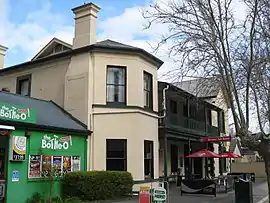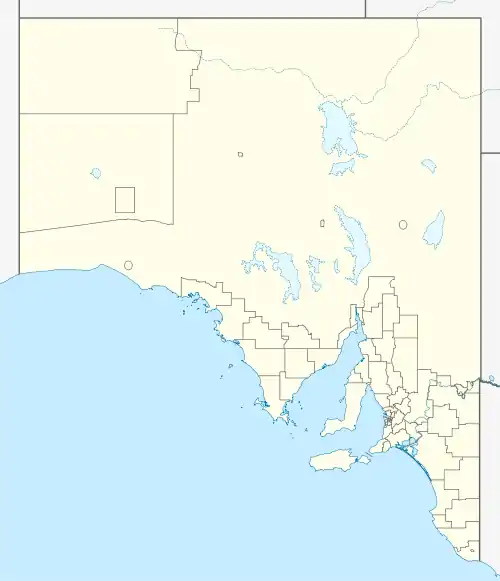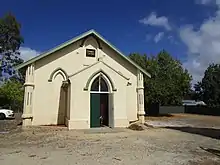Mount Pleasant, South Australia
Mount Pleasant is a town situated in the Barossa Council, just north of the Adelaide Hills region of South Australia, 55 kilometres east-north-east of the state capital, Adelaide (34°46′S 139°3′E). It is located in the Barossa Council and Mid Murray Council local government areas, and is at an altitude of 440 metres above sea level. Rainfall in the area averages 687 mm per annum.
| Mount Pleasant South Australia | |||||||||||||||
|---|---|---|---|---|---|---|---|---|---|---|---|---|---|---|---|
 The Totness Inn Hotel on the main street of Mount Pleasant | |||||||||||||||
 Mount Pleasant | |||||||||||||||
| Coordinates | 34.773°S 139.051°E | ||||||||||||||
| Population | 1,020 (2016 census)[1] | ||||||||||||||
| Established | 1843 | ||||||||||||||
| Postcode(s) | 5235 | ||||||||||||||
| Location | 55 km (34 mi) East of Adelaide via | ||||||||||||||
| LGA(s) | |||||||||||||||
| State electorate(s) | Schubert | ||||||||||||||
| Federal Division(s) | Barker | ||||||||||||||
| |||||||||||||||
History
Origin of the name
Today's Mount Pleasant comprises three townships, Totness, Talunga and Hendryton. Mount Pleasant township was developed by Henry Glover, and surveyed in 1856. It comprised the land from Railway Terrace to Saleyard Road. The name was taken from that used by James Phillis, who had come from an area near Eastry in Kent. The land had reminded him of his homeland. His sister was named Pleasant, who may also have inspired the name.
Totness was surveyed in 1858, with Henry Giles Sr. as the developer; this was the section from Saleyard Road to Pentelows Road. It was named after the birthplace of Henry's wife, Mary Ann. Henry also developed North Totness, which is the land from Pentelows Road to the Walkers Flat Road, surveyed in 1869. John Hendry, a blacksmith living in Totness, developed the land to the west of Mount Pleasant, comprising that from the Cricks Mill Road (to Williamstown) to Railway Terrace, and this was surveyed in 1865.
European settlement
The first European explorers through the Mount Pleasant district were Dr George Imlay and John Hill in January 1838.[2] Settlers moved into the area in the late 1830s with flocks of sheep and with bags of grain. One of the early settlers, James Phillis, had arrived in Adelaide in 1839 and literally rode a horse into the Adelaide Hills looking for suitable land to farm. He settled at Mount Pleasant in 1843, planted wheat, harvested the crop, and then had to take it to Adelaide to sell. From the profits he sailed to England where he bought a flock of Romney Marsh sheep which he shipped back to the area. Over the years he became one of the district's most prosperous and successful farmers. This is an extract from an article written by Nancy Mavis Pike (née Phillis). Several of Mt Pleasant's pioneer families were to lose sons in the Great War, like William Polden who is now buried in The Lone Pine Cemetery, Gallipoli.

A small quantity of gold was found in the district in the 1860s, but not enough to attract significant mining activity. The town remained a small service centre for the region. The original police station, from the 1860s, has been largely replaced by a newer building. The main street, Melrose Street, is lined with plane trees.[3]
Mount Pleasant was the centre of its own municipality, the District Council of Mount Pleasant, from 1935 until 1997 when it was divided between the larger Barossa Council and Mid Murray Council. Mount Pleasant township is now part of the Barossa Council.
Geography
Mount Pleasant is located 10 km north-east of Birdwood heading towards Springton, Eden Valley and Angaston.
At the ABS 2001 census, Mount Pleasant had a population of 529 people living in 240 dwellings.
Facilities
Mount Pleasant has a primary school, kindergarten, a district hospital, volunteer ambulance station, butcher, general store, golf club, chemist, two bakeries, two pubs, hairdresser, showgrounds featuring the annual Mount Pleasant show, a weekly Saturday Farmer's market, caravan park, RSL and a football club [7]
Transport
A coach is operated from Tea Tree Plaza Interchange to Gumeracha and Mount Pleasant by Affordable Coachlines.[8] A private coach service also goes from Birdwood to the Barossa Valley via Mount Pleasant.[9]
Mount Pleasant was once the terminus of the Mount Pleasant railway line which branched from the Adelaide to Murray Bridge line at Balhannah.[10] The line[11] opened on 16 September 1918 and was closed on 4 March 1963, following improved road conditions via the Adelaide-Mannum Road. The former rail corridor can still be seen from a few roads, and is gradually being converted, from Balhannah towards Mount Pleasant, into a cycling, walking and horseback riding trail known as the Amy Gillett Bikeway. As of 2015, this conversion had reached Mount Torrens.
See also
References
- Australian Bureau of Statistics (25 October 2007). Mount Pleasant (L) (Urban Centre/Locality). 2016 Census Quickstats. Retrieved on 2008-05-29
- "SOUTH AUSTRALIA". The Australian. 27 March 1838. p. 3.
- Travel – Mount Pleasant, Sydney Morning Herald, 8 February 2004. Accessed 18 June 2006.
- "Cottage & Barn". South Australian Heritage Register. Department of Environment, Water and Natural Resources. Retrieved 28 May 2016.
- "Mount Pleasant Police Station & Cells". South Australian Heritage Register. Department of Environment, Water and Natural Resources. Retrieved 28 May 2016.
- "Rosebank Shearing Shed". South Australian Heritage Register. Department of Environment, Water and Natural Resources. Retrieved 28 May 2016.
- White Pages Online. Accessed 18 June 2006.
- Timetable, Affordable Coachlines. Accessed 15 June 2006
- Timetable Archived 17 June 2006 at the Wayback Machine, Barossa Valley Coachlines. Accessed 18 June 2006
- Sallis, Roger (1998). Railways in the Adelaide Hills, 1st edition. Openbook Publishers, Adelaide. ISBN 0-646-35473-6.
- The Mount Pleasant Line Callaghan, W.H. Australian Railway Historical Society Bulletin, October, 1994 pp274-281
Further reading
| Wikimedia Commons has media related to Mount Pleasant, South Australia. |
- The Quiet Waters By : The Mount Pleasant District 1843–1993, written by Reg Butler